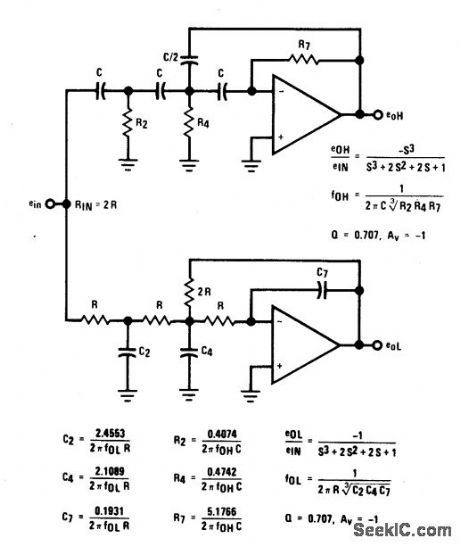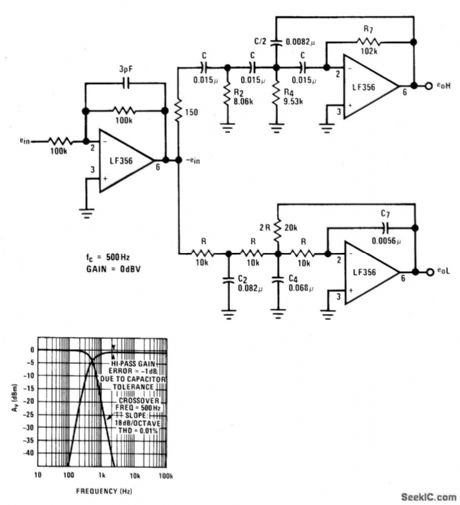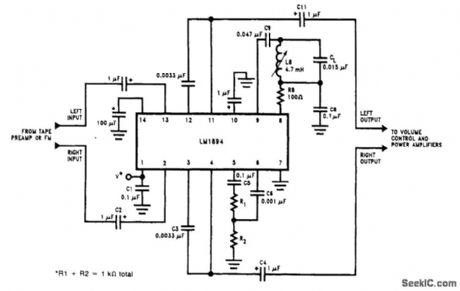
Analog Circuit
Index 10
THIRD_ORDER_BUTTERWORTH_CROSSOVER_NETWORK
Published:2009/6/24 20:38:00 Author:May
View full Circuit Diagram | Comments | Reading(0)
ACTIVE_CROSSOVER_NETWORK
Published:2009/6/24 20:36:00 Author:May
View full Circuit Diagram | Comments | Reading(0)
FAST_TURN_ON_DELAYED_OFF_RELAY_CIRCUIT
Published:2009/6/24 5:41:00 Author:May
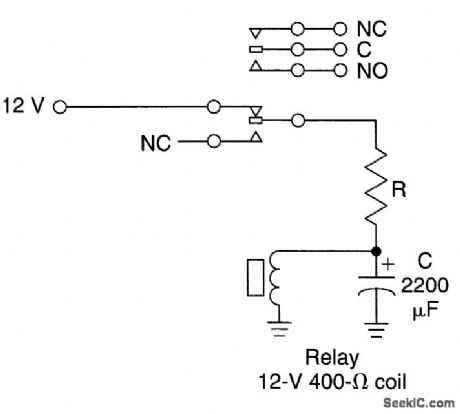
C is a large capacitor that has a charge time of RSUPPLY C, assuming RSUPPLY <Rcoil, The discharge time will be Rcoil C neglecting relay coil inductance. With C = 10,000 μF and Rcoil 500 Ω, a release time constant of 5 seconds might be obtained. Many relays will hold in until the coil current decays to 25% of the pull-in current so that the actual time constant depends on the relay holding current. (View)
View full Circuit Diagram | Comments | Reading(0)
ZERO_VOLTAGE_SWITCHING_TEMPERATURE_REGULATOR
Published:2009/6/24 4:32:00 Author:May

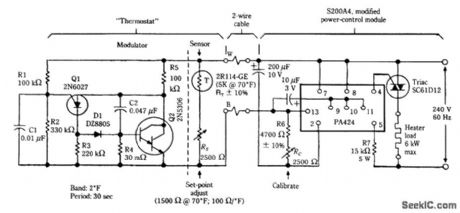
In this arrangement, an integral number of cycles of ac is fed to the heater. No RFI or EMI is gen-erated with this method. The thermostat uses a thermistor as a sensor. The PA424 (GE) device gen-erates trigger pulses for the triac only at zero crossings of the ac line cycle. (View)
View full Circuit Diagram | Comments | Reading(1507)
5_TO_33_V_SURFACE_MOUNT_SWITCHING_REGULATOR
Published:2009/6/24 5:29:00 Author:May
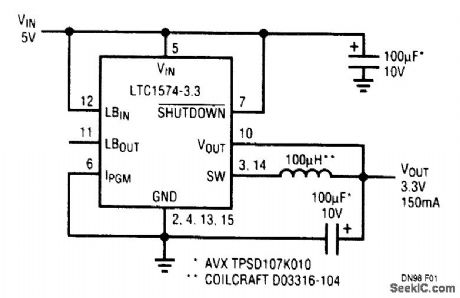
This converter provides 3.3 V at 150 mA from an input voltage of 5 V. Peak inductor current is limited to 340 mA by connecting pin 6 (IPGM) to ground. For applications requiring higher output current, connect pin 6 to Vin. Under this condition, the maximum load current is increased to 425 mA. (View)
View full Circuit Diagram | Comments | Reading(670)
POSITIVE_REGULATOR_SINKS_CURRENT
Published:2009/6/24 5:28:00 Author:May
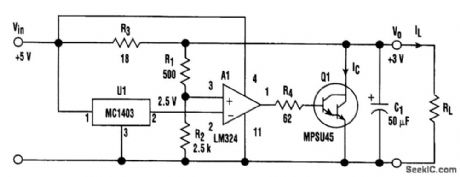
Generally speaking, conventional positive voltage regulators can only source current; they can't sink it. However, the positive regulator shown breaks that rule because it can perform both functions.The idea is to have the control transistor Q1 in shunt so that the regulator can either source or sink current.The circuit provides +3-V output from a +5-V supply. U1 is a bandgap reference that supplies a stable +2.5-V reference to the error amplifier (A1). The output voltage (VO) is sampled by the resis-tor network (R1 and R2). If VO were to increase, A1 will drive the base of Q1 harder, increasing the collector current (IC).This increases the drop across R3 and VO decreases, thus regulating the output voltage. The output voltage is givenby VO = 2.5(1 + R1/R2)Under no load conditions, Q1 draws 110 mA [(Vin-VO)/R3]. With a load connected, and as the regulator begins to source load current (IL), IC decreases to keep the drop across R3 constant.At IL 100 mA, Q1 carries 10 mA. If RL is connected to the positive supply higher than VO, then the regulator must sink current, and IL becomes negative. At IL = -100 mA, Q1 carries 210 mA while maintaining the output voltage at +3 V. The output voltage will remain constant at +3 V—even if the load current changes sign.With the proper heatsink on Q1, the regulator can sink more than 300 mA. If a sink only option is desired, the dissipation in Q1 can be reduced by using a 180-Ω resistor for R3. R4 limits the base current drive for Q1 and prevents the output of A1 from being clamped at 2 VBE. (View)
View full Circuit Diagram | Comments | Reading(1013)
SIMPLE_NOISE_LIMITER
Published:2009/6/24 5:25:00 Author:May
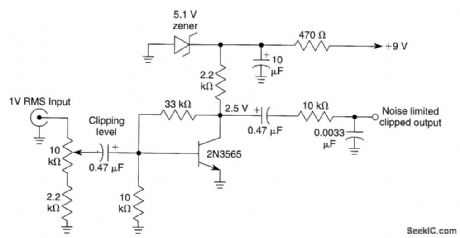
This circuit uses a symmetrical limiter obtained by biasing a transistor to a Q point that is half of the supply voltage and driving it into saturation and cutoff. An input of 1 to 2 V RMS is sufficient. This output will be approximately 4Vp-p into a high-impedance load. (View)
View full Circuit Diagram | Comments | Reading(1074)
ADJUSTABLE_NOISE_CLIPPER
Published:2009/6/24 5:22:00 Author:May
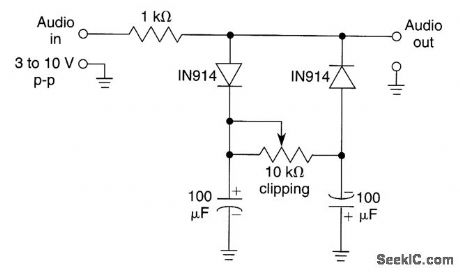
This circuit uses two diodes and is a peak-to-peak limiter. The capacitors charge up to a dc level determined by the peak-to-peak audio signal and the clipping control. A positive or negative peak or spike is clipped if it exceeds this level plus the diode drops. The circuit should be operated at several volts level for best results. (View)
View full Circuit Diagram | Comments | Reading(4092)
LOW_DROPOUT_REGULATOR
Published:2009/6/24 5:22:00 Author:May
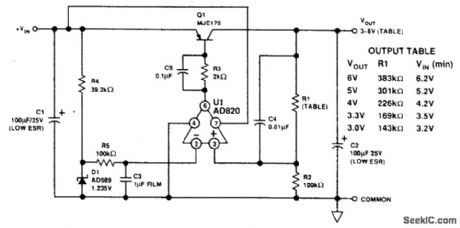
This low-dropout reference produces a 4.5-V output from a supply just a few hundred mV loading, With 1-mA dc loading,it maintains a stable 4.5-V output for inputs down to 4.7 V. (View)
View full Circuit Diagram | Comments | Reading(0)
AUDIO_NOISE_BASED_VOTING_CIRCUIT
Published:2009/6/24 5:21:00 Author:May
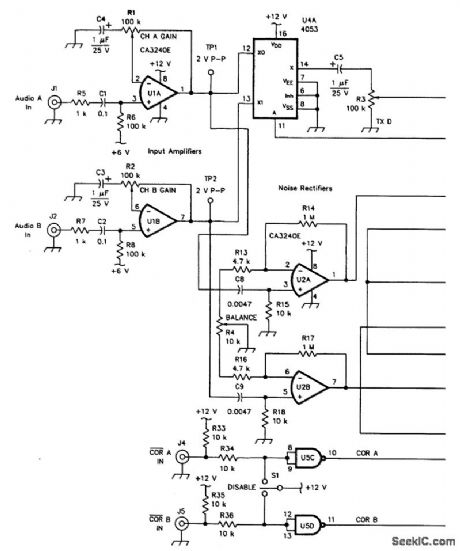
The purpose of this circuit is the selection of the output of two receivers, tuned to the same channel, that has the better signal to noise ratio. This circuit compares the two noise leads from the receivers and selects the one with the lower audio noise level. (View)
View full Circuit Diagram | Comments | Reading(753)
LOW_NOISE_REGULATOR(5_TO_33_V)
Published:2009/6/24 5:16:00 Author:May
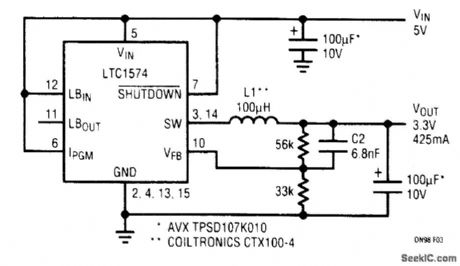
In some applications, it is important not to introduce any switching noise within the audio frequency range. To circumvent this problem, a feed-forward capacitor can be used to shift the noise spectrum up and out of the audio band with C2 being the feed-forward capacitor. The peak-to-peak output ripple is reduced to 30 mV over the entire load range. A toroidal surface mount inductor L1 is chosen for its excellent self-shielding properties. (View)
View full Circuit Diagram | Comments | Reading(563)
DUAL_OUTPUT_REGULATOR
Published:2009/6/24 5:14:00 Author:May
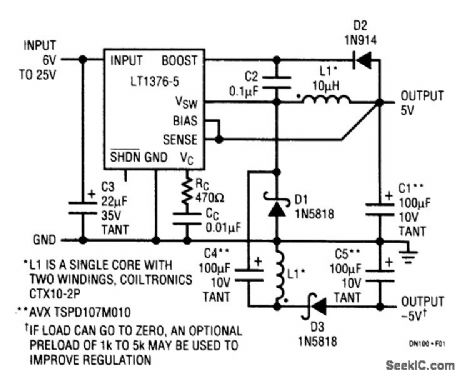
If load can go to zero, an optional preload of 1 to 5 kΩ can be used to improve regulation. Many modern circuit designs still need a dual polarity supply. Communication and data acquisition are typical areas where both 5 V and -5 V are needed for some of the IC chips.The current mode architecture and saturating switch design allow the LT1376 to deliver up to 1.5-A load current from the 8-pin SO package. L1 is a 10-μH surface-mount inductor from Coiltronics. The second winding is used to create a negative-output SEPIC (Single-Ended Primary Inductance Converter) topoLogy using D3, C4, C5, and the second half of F1. This converter takes advantage of the fact that the switching signal driving L1 as a positive buck converter is already the correct amplitude for driving a -5-V SEPIC converter. During switch-off time, the voltage across L is equal to the 5-V output plus the forward voltage of D1. An identical voltage is generated in the sec-ond winding, which is connected to generate -5 V using D3 and C5. Without C4, this would be a simple flyback winding connection with modest regulation. The addition of C4 creates the SEPIC topology. Note that the voltages swing at both ends of C4 is theoretically identical-even without the capacitor. The undotted end of both windings goes to a zero ac voltage node, so the equal windings will have equal voltages at the opposing ends. Unfortunately, coupling between windings is never perfect, and load regulation at the negative output suffers as a result. The addition of C4 forces the wind-ing potentials to be equal and (View)
View full Circuit Diagram | Comments | Reading(803)
DOLBΥ_NOISE_REDUCTION_CIRCUIT
Published:2009/6/24 5:14:00 Author:May
View full Circuit Diagram | Comments | Reading(678)
LOW_COST_STEP_DOWN_REGULATOR
Published:2009/6/24 5:10:00 Author:May
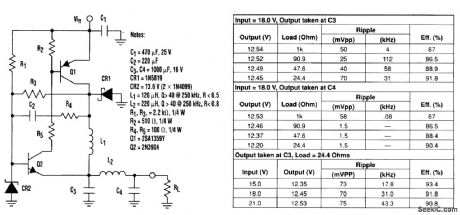
This inexpensive and efficient discrete step-down regulator is based on a complementary transistor arrangement that uses both positive and negative feedback and is referenced to a Zener diode. Inductor L1 is selected to maintain the switching frequency above the audible range for the intended operating load. The output filter L2 and C4 reduces ripple to less than 10 mV p-p over a large range of loads, with only a slight decrease in efficiency. (View)
View full Circuit Diagram | Comments | Reading(887)
33_V_1_A_SURFACE_MOUNT_REGULATOR
Published:2009/6/24 5:02:00 Author:May
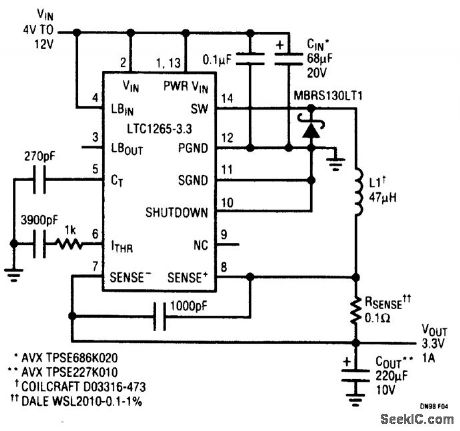
This figure shown a tuopical LTC1265 surface-mount application.It provides 3.3 V at 1 A from an input voltage range of 4 V to 12 V.The peak efficiency approaches 93% at mid-current levels. (View)
View full Circuit Diagram | Comments | Reading(662)
NEGATIVE_VOLTAGE_REFERENCE
Published:2009/6/24 5:01:00 Author:May
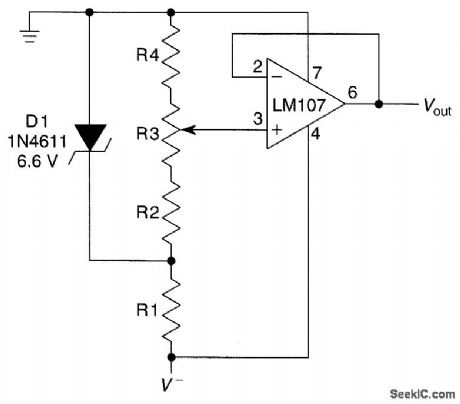
D1 is used as a reference. R2, R3, and R4 are voltage dividers to obtain desired output voltage to the op-amp voltage follower. (View)
View full Circuit Diagram | Comments | Reading(786)
POSITIVE_VOLTAGE_REFERENCE
Published:2009/6/24 5:00:00 Author:May
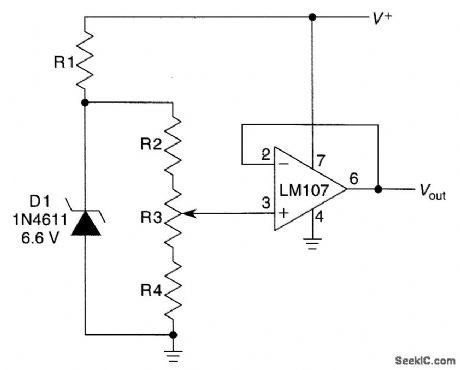
D1 is used as a reference. R2, R3, and R4 provide desired output voltage to the op-amp voltage follower. (View)
View full Circuit Diagram | Comments | Reading(754)
LOW_VOLTAGE_REFERENCE
Published:2009/6/24 4:59:00 Author:May
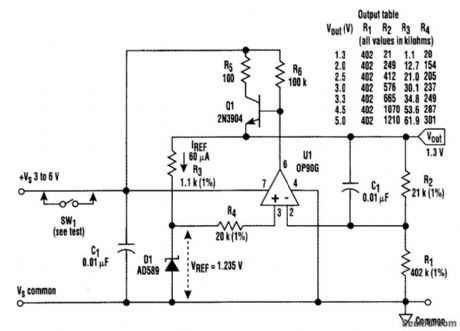
This circuit illustrates a number of techniques that are useful for low-voltage, series-mode, power-efficient references. Intended for output currents of up to 10 mA, this design has an enabled standby current of about 100 μA; it can be easily programmed over a wide range of output voltages. (View)
View full Circuit Diagram | Comments | Reading(739)
OLD_FASHIONED_CRYSTAL_RADIO
Published:2009/6/24 4:55:00 Author:May

L1 and L2 are wound on 4 diameter 10 form and are 200 tums of #24 wire. PVC pipe can be used. (View)
View full Circuit Diagram | Comments | Reading(671)
VARIOMETER_TUNED_RADIO
Published:2009/6/24 4:54:00 Author:May
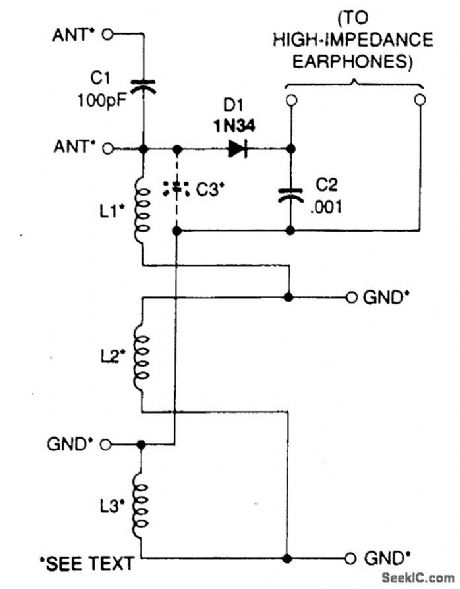

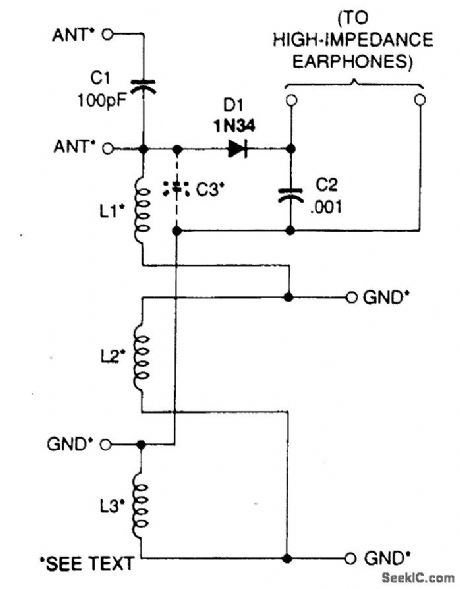
The two fixed coils of the variometer, L1 and L3, are wound on an S)G-inch-long piece of 1-inch-diameter plastic pipe (its outer diameter is about 1 1/4 inches). Each coil is 2 1/4 inches long. The num-ber of turns is not critical, but 86 tightly wound turns of #22 enameled wire were used. When winding the coils, make sure you start at a point that will allow them to be placed 2 inches apart on the pipe. Drill holes in the pipe and run the leads of the coils out the end of the pipe that is closest to each.The movable coil, L2, is wound on a piece of 1 1/2-inch plastic pipe (its outer diameter is about 1 7/8inches). The winding is 2 inches long. Like L1 and L3, the actual number ofwindings of this coil are not critical, as long as the winding is approximately the right length. (View)
View full Circuit Diagram | Comments | Reading(826)
| Pages:10/24 1234567891011121314151617181920Under 20 |
Circuit Categories
power supply circuit
Amplifier Circuit
Basic Circuit
LED and Light Circuit
Sensor Circuit
Signal Processing
Electrical Equipment Circuit
Control Circuit
Remote Control Circuit
A/D-D/A Converter Circuit
Audio Circuit
Measuring and Test Circuit
Communication Circuit
Computer-Related Circuit
555 Circuit
Automotive Circuit
Repairing Circuit
